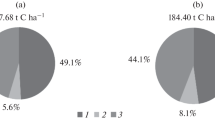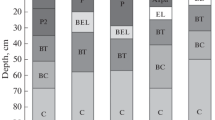Abstract
The current state of the solonetz and ground elder–sedge types upland oak forests of in the Tellermanovsky forest has been studied. The phytomass of forest stands was estimated based on model trees with allowance for the types of their development (according to the original classification). The content and stocks of carbon and nitrogen in phytomass, forest litter, and soil have been evaluated. It was found that the phytomass of oak forests in similar plantations is lower than that before the period of oak drying (in the 1970s to the early 1980s). The mass of fallen leaves and forest litter corresponds to the previous values due to the development of the lower tree layers. The studied oak forests differ most sharply by the stocks of carbon and nitrogen in the phytomass and much less by their reserves in the soil, capacity and rate of the annual cycle. The content of carbon, nitrogen, and nonstructural carbohydrates in the organs of the oak in these oak forests is similar.
Similar content being viewed by others
Notes
Early and late phenoforms are phenological forms that differ in the onset of phenophases.
The sum of readily soluble salts was calculated from the concentration of ions passing into the water extract.
The primary and secondary crown differ in origin. The primary crown forms simultaneously with the growth of the trunk, and the secondary crown develops from water shoots.
Water shoots are shoots formed from dormant buds.
REFERENCES
Bespalov, V.P., Water shoots and their role in ontogenesis of the Siberian elm, Materialy soveshchaniya “Lesnye statisonarnye issledovaniya: metody, rezul’taty, perspektivy” (Proc. Conf. “Forest Stationary Studies: Methods, Results, and Prospects”), Tula: Grif i K, 2001, pp. 465–467.
Dubravy lesostepi v biogeotsenoticheskom osveshchenii (Biogeocenosises of the Forest-Steppe Oak Forests), Molchanov, A.A., Ed., Moscow: Nauka, 1975.
Ekosistemy Tellermanovskogo lesa (Ecosystems of the Tellerman Forest), Osipov, V.V., Ed., Moscow: Nauka, 2004.
Elagin, I.N. and Mina, V.N., The structure of oak root systems on dark-gray forest soils and solonchaks, Tr. Inst. Lesa, Akad. Nauk SSSR, 1953, vol. 12, pp. 151–170.
Il’yushenko, A.F. and Romanovskii, M.G., Development of secondary crown of the common oak and its role in dynamics of wood stands, Lesovedenie, 2000, no. 3, pp. 65–72.
Kaplina, N.F., Influence of crown development on radial growth of early and late wood of the common oak trunk, Vestn. Povolzh. Gos. Tekhnol. Univ., Ser. Les. Ekol., Prirodopol’z., 2019, no. 2 (42), pp. 17–25.
Kaplina, N.F. and Kulakova, N.Yu., The content of non-structural carbohydrates in the organs of the common oak in the conditions of the southern forest-steppe of the European part of Russia, Vestn. Povolzh. Gos. Tekhnol. Univ., Ser. Les. Ekol., Prirodopol’z., 2015, no. 4 (28), pp. 84–97.
Kaplina, N.F. and Selochnik, N.N., Crown morphology and state of the common oak in middle-aged stands of forest-steppe, Lesovedenie, 2009, no. 3, pp. 32–42.
Kaplina, N.F. and Selochnik, N.N., Current and long-term state of the common oak in three contrast forest types of the southern forest-steppe, Lesovedenie, 2015, no. 3, pp. 191–201.
Kaplina, N.F. and Zhirenko, N.G., Dynamics of leaf phytomass, state and development of tree crowns in upland oak forests of the southeastern forest-steppe under unfavorable conditions over last decade, Vestn. Povolzh. Gos. Tekhnol. Univ., Ser. Les. Ekol., Prirodopol’z., 2012, no. 2, pp. 3–11.
Kulakova, N.Yu., Soil conditions on the range edge of the common oak (Quercus robur L.) in the southern forest-steppe of European part of Russia, Vestn. Povolzh. Gos. Tekhnol. Univ., Ser. Les. Ekol., Prirodopol’z., 2018, no. 3 (39), pp. 16–29.
Praktikum po agrokhimii (Practical Manual on Agricultural Chemistry), Mineev, V.G., Ed., Moscow: Mosk. Gos. Univ., 2001.
Rubtsov, V.V. and Utkina, I.A., Adaptatsionnye reaktsii duba na defoliatsiyu (Adaptive Reactions of the Oak on Defoliation), Moscow: Inst. Lesoved., Ross. Akad. Nauk, 2008.
Shishov, L.L., Tonkonogov, V.D., Lebedeva, I.I., and Gerasimova, M.I., Klassifikatsiya i diagnostika pochv Rossii (Classification and Diagnostic System of Russian Soils), Smolensk: Oikumena, 2004.
Shvidenko, A., Shchepashchenko, D.G., Nilsson, S., and Buluy, Y.I., Tables and Models of Growth and Productivity of Forests of Major Forest Forming Species of Northern Eurasia (Standard and Reference Materials), Moscow: Fed. Agency For. Manage., 2008. http://webarchive.iiasa. ac.at/Research/FOR/forest_cdrom/Articles/THR.pdf. Accessed May 10, 2020.
Sostoyanie dubrav lesostepi (The State of Oak Forests in Forest-Steppe), Orlov, A.Ya. and Osipov, V.V., Eds., Moscow: Nauka, 1989.
ACKNOWLEDGEMENTS
The authors are grateful to the staff and graduate students of the Institute of Natural Sciences of the Russian Academy of Sciences and the staff of the Tellermanovsky experimental forestry who took part in the field study.
Funding
The work was carried out on the subject of State Assignment no. NIOKTR AAAA-A19-119053090075-4, “Factors and mechanisms of the stability of natural and artificial forest biogeocenoses of the forest–steppe zone and arid regions of European Russia under the conditions of natural–anthropogenic transformations.”
Author information
Authors and Affiliations
Corresponding authors
Ethics declarations
Conflict of Interests. The authors declare that they have no conflicts of interest.
Statement on Animal Welfare. This article does not contain any studies involving animals performed by any of the authors.
Additional information
Translated by M. Shulskaya
Rights and permissions
About this article
Cite this article
Kaplina, N.F., Kulakova, N.Y. Phytomass and Carbon and Nitrogen Reserves in the Upland Oak Forests of the Southern Forest Steppe. Arid Ecosyst 11, 27–33 (2021). https://doi.org/10.1134/S2079096121010091
Received:
Revised:
Accepted:
Published:
Issue Date:
DOI: https://doi.org/10.1134/S2079096121010091




